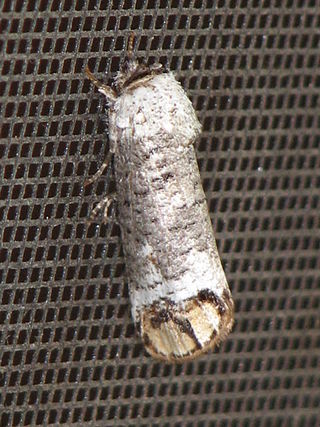Related Research Articles

Butterflies (Rhopalocera) are insects that have large, often brightly coloured wings, and a conspicuous, fluttering flight. The group comprises the superfamilies Hedyloidea and Papilionoidea. Butterfly fossils have been dated to the Paleocene, about 56 million years ago.

Lepidoptera is an order of insects that includes butterflies and moths. About 180,000 species of the Lepidoptera are described, in 126 families and 46 superfamilies, 10 percent of the total described species of living organisms. It is one of the most widespread and widely recognizable insect orders in the world. The Lepidoptera show many variations of the basic body structure that have evolved to gain advantages in lifestyle and distribution. Recent estimates suggest the order may have more species than earlier thought, and is among the four most species-rich orders, along with the Hymenoptera, Diptera, and Coleoptera.

Moths are a group of insects that includes all members of the order Lepidoptera that are not butterflies. They were previously classified as suborder Heterocera, but the group is paraphyletic with respect to butterflies and neither subordinate taxa are used in modern classifications. Moths make up the vast majority of the order. There are thought to be approximately 160,000 species of moth, many of which have yet to be described. Most species of moth are nocturnal, although there are also crepuscular and diurnal species.

The Satyrinae, the satyrines or satyrids, commonly known as the browns, are a subfamily of the Nymphalidae. They were formerly considered a distinct family, Satyridae. This group contains nearly half of the known diversity of brush-footed butterflies. The true number of the Satyrinae species is estimated to exceed 2,400.

Castniidae, or castniid moths, is a small family of moths with fewer than 200 species: The majority are Neotropical with some in Australia and a few in south-east Asia. These are medium-sized to very large moths, usually with drab, cryptically-marked forewings and brightly coloured hindwings. They have clubbed antennae and are day flying, and are often mistaken for butterflies. Indeed, some previous classification systems placed this family within the butterflies or skippers. The Neotropical species are commonly known as giant butterfly-moths, the Australian and Asian species as sun moths. The larvae are internal feeders, often on roots of epiphytes or on monocotyledons.

The Cossidae, the cossid millers or carpenter millers, make up a family of mostly large miller moths. This family contains over 110 genera with almost 700 known species, and many more species await description. Carpenter millers are nocturnal Lepidoptera found worldwide, except the Southeast Asian subfamily Ratardinae, which is mostly active during the day.

Hedylidae, the "American moth-butterflies", is a family of insects in the order Lepidoptera, representing the superfamily Hedyloidea. They have traditionally been viewed as an extant sister group of the butterfly superfamily Papilionoidea, but a 2014 phylogenetic analyses has suggested Hedylidae is a subgroup of Papilionoidea, and not a sister group, and are more accurately referred to as butterflies rather than moths. They are represented by a single Neotropical genus Macrosoma with 35 currently recognized species.

Rhodometra sacraria, the vestal, is a moth of the family Geometridae. The species was first described by Carl Linnaeus in his 1767 12th edition of Systema Naturae.

Battus polydamas, also known as the gold rim swallowtail, the Polydamas swallowtail or the tailless swallowtail, is a species of butterfly in the family Papilionidae. The species was first described by Carl Linnaeus in his 10th edition of Systema Naturae, published in 1758.
The following are the regional Lepidoptera lists by continent. Lepidoptera is the insect order consisting of both the butterflies and moths.
Chirgus barrosi is a species of butterfly of the family of Hesperiidae, first described in 1956 by Emilio Ureta. It is known from Chile, where it is found at high altitudes in sandy locations with leguminous plants.

Anaea are a genus of charaxine butterflies in the brush-footed butterfly family Nymphalidae. The butterflies are commonly known as leafwings. Members of the genus are found throughout the United States, Central America, and the Caribbean.